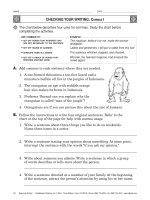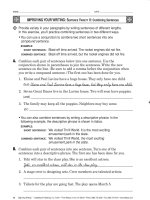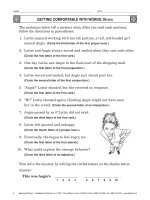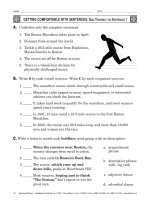Beginning writing 2 part 5
Bạn đang xem bản rút gọn của tài liệu. Xem và tải ngay bản đầy đủ của tài liệu tại đây (108.32 KB, 10 trang )
28
Beginning Writing 2
• Saddleback Publishing, Inc. © 2001 • Three Watson, Irvine, CA 92618 • Phone: (888) 735-2225 • Fax: (888) 734-4010 • www.sdlback.com
NAME DATE
IMPROVING SENTENCES: W
ORD
C
ONNOTATIONS
Word
connotations
are the ideas and feelings that most people associate
with certain words. These feelings go beyond the word’s actual definition.
For example, the words
slender
and
skinny
have similar definitions. Each
word, however, calls up different ideas and emotions. One is likely to make
a reader think of good, positive things. The other is a negative word. You
can use word connotations to get your message across to your reader.
A.
Circle the word in each group that has the most positive connotation.
1. argue, discuss, quarrel 3. tall, stately, gangly
2. nag, pester, remind 4. conceited, snobbish, confident
B.
Circle the word in each group that has the most negative connotation.
1. bossy, forceful, commanding 3. shy, bashful, reserved
2. smile, grin, smirk 4. mellow, easy-going, lazy
C.
Look at the connotation ladder
below. The center box contains a
neutral word. The upper boxes
contain synonyms with more
positive connotations. The lower
boxes contain synonyms with
more negative connotations.
Now create your own connotation
ladder, using words from the box.
cheap economical frugal
stingy tight-fisted thrifty
CHALLENGE: The following sentences create negative pictures. On the
back of this sheet, rewrite the sentences to suggest pleasant ideas. Just
change the boldface words to words with more positive connotations.
1. Lynn’s mother badgered her about doing her homework.
2. Julia’s little brother, Alvin, tagged along wherever she went.
extraordinary
unique
unusual
strange
odd
weird
bizarre
+
0
–
price-conscious
+
0
–
Saddleback Publishing, Inc. © 2001 • Three Watson, Irvine, CA 92618 • Phone: (888) 735-2225 • Fax: (888) 734-4010 • www.sdlback.com •
Beginning Writing 2
29
NAME DATE
IMPROVING SENTENCES: F
IGURES
OF
S
PEECH
I
Figures of speech
are expressions that the writer doesn’t mean to be taken
literally. Look at this example:
The parking attendant waved his arms like a
windmill.
The writer doesn’t mean that the attendant’s arms
really
went all the
way around like a windmill. The figure of speech is used to create a lively,
interesting picture for the reader.
The chart below shows two kinds of common figures of speech.
A.
Figures of speech help a reader understand exactly what the writer means.
Circle the letter of the sentence in each pair that creates a clearer picture.
1. a. As I entered the boxing ring, I saw that I was much smaller and
weaker than my opponent.
b. As I entered the boxing ring, I saw that I was a toy poodle facing a wolf !
2. a. The autumn leaves crunched like potato chips under our feet.
b. The autumn leaves crunched loudly under our feet.
3. a. My little sister is like a puppy, following on my heels wherever I go.
b. My little sister always follows me closely wherever I go.
B.
Underline the two items being compared in each sentence. Then write
S or M on the line to show whether the figure of speech is a simile or
metaphor. The first one has been done for you.
1. _____ Like
ants approaching a picnic basket, the children marched
single file toward the sea.
2. _____ The sun, a blazing ball of fire, tanned the children’s faces.
3. _____ “Don’t forget your sunscreen!” the mother-hen of a teacher clucked.
4. _____ Her students were already rolling in the sand like playful puppies.
CHALLENGE: On the back of this sheet, write your own similes and
metaphors by completing the following comparisons:
The wind was a . . . The classroom sounded like . . .
FIGURE OF
SPEECH
Simile
Metaphor
DEFINITION
a comparison of two unlike things;
uses the word
like
or
as
an implied comparison of unlike
things; does not use
like
or
as
EXAMPLE
The snow on the hill was like
vanilla frosting on a cupcake.
The coast highway is
a roller coaster.
S
30
Beginning Writing 2
• Saddleback Publishing, Inc. © 2001 • Three Watson, Irvine, CA 92618 • Phone: (888) 735-2225 • Fax: (888) 734-4010 • www.sdlback.com
NAME DATE
IMPROVING SENTENCES: F
IGURES
OF
S
PEECH
II
The following chart shows two figures of speech that writers use. Readers should
not take these expressions literally. Writers use them to make their ideas clear.
A.
Each sentence contains one figure of speech. Draw lines to match each
sentence with the figure of speech it contains.
1. He found himself in the cold clutches of
cruel jealousy.
2. My ideas are Ping-Pong balls bouncing
within my head.
3. Like a robot, Stanley moved along the
assembly line.
4. I’ll die if anyone sees me in these pants!
a. simile
b. metaphor
c. personification
d. hyperbole
B.
The world’s greatest writers often used figures of speech. Identify the
figure of speech used in each quotation. On each line, write S for simile,
M for metaphor, P for personification, or H for hyperbole.
1. _____ The horse was just a raging torrent inside.
–Sherwood Anderson
2. _____ All the world’s a stage, / And all the men and women,
merely players.
–
Shakespeare (“As You Like It”)
3. _____ His master’s voice acted on Buck like an electric shock.
–
Jack London (Call of the Wild)
4. _____ There came a wind like a bugle; / It quivered in through
the grass.
–Emily Dickinson
5. _____ The last time I saw Paris, her heart was warm and gay . . .
–Oscar Hammerstein
6. _____ You have been crying until you are half-blind . . .
–
Charles Dickens (Great Expectations)
7. _____ A horse! A horse! My kingdom for a horse!
–Shakespeare (Richard III)
CHALLENGE: On the back of this sheet, write a paragraph describing a
memorable airplane flight, boat trip, train ride, or hike. Use at least two
different figures of speech.
FIGURE OF
SPEECH
Personification
Hyperbole
DEFINITION
giving the qualities of life
to an object or idea
a gross exaggeration
EXAMPLE
“Winter’s coming,” whispered
the icy wind.
I’ll get those tickets if I have to
wait in line a hundred years!
Saddleback Publishing, Inc. © 2001 • Three Watson, Irvine, CA 92618 • Phone: (888) 735-2225 • Fax: (888) 734-4010 • www.sdlback.com •
Beginning Writing 2
31
NAME DATE
IMPROVING SENTENCES: A
VOIDING
C
OMMON
P
ITFALLS
The chart below shows three common writing errors. Study the information to
help you avoid the problems described.
Identify the writing problem in each sentence. Write NP for non-parallel
structure, DM for dangling modifier, or MM for misplaced modifier.
1. _____ Standing at the door, the room seems very large.
2. _____ Hanging on a hook in my locker, I saw my red backpack.
3. _____ In the dark I recognized my cousin by her laugh, her voice,
and because her perfume smelled familiar.
4. _____ At age 87, the day came when Benjamin Franklin died.
5. _____ Ben Franklin was known for being thrifty, wise, and he had
a good sense of humor.
6. _____ The oldest member of the Constitutional Convention, the
U.S. Constitution and the Declaration of Independence were
both signed by Ben Franklin.
7. _____ After warming up, the trumpets began to play.
8. _____ Thanking everyone for coming, the party ended with a
speech by the host.
9. _____ Would you rather be a police officer, a firefighter, or work
in an auto mechanic’s garage?
10. _____ After tightening the bolts on the wheel, the car was ready to roll.
CHALLENGE: Select three sentences from Part A—one for each of the
three writing errors. On the back of this sheet, rewrite the sentences
you chose, making the needed corrections.
ERROR
non-parallel
structure
dangling
modifiers
misplaced
modifiers
EXAMPLE
(
INCORRECT
) We had fun swimming,
sunbathing, and on surfboards.
(
CORRECT
) We had fun swimming,
sunbathing, and surfing.
(
INCORRECT
) Exhausted from a late-night
party, my test score was 0.
(
CORRECT
) Exhausted from a late-night
party, I got a 0 on my test.
(
INCORRECT
) I photographed my dog
using a new camera.
(
CORRECT
) Using a new camera,
I photographed my dog.
CORRECTION
Similar parts, or elements,
of a sentence must be in
the same form.
Make sure the word a
phrase describes is in
the sentence!
Descriptive words should
be close to the word they
modify!
32
Beginning Writing 2
• Saddleback Publishing, Inc. © 2001 • Three Watson, Irvine, CA 92618 • Phone: (888) 735-2225 • Fax: (888) 734-4010 • www.sdlback.com
NAME DATE
IMPROVING SENTENCES: P
ROOFREADING
AND
R
EPAIRING
E
RRORS
Before you write a final copy, you should proofread and edit your rough draft. This
chart of standard proofreader’s marks can help you mark different kinds of errors.
EXAMPLE:
dont recopy your papper until youve proofred your your work.
A.
Proofread the paragraph below. Find and mark three errors in each sentence.
Long ago the greeks held contests to to honor a god Athletes from a
round the land gathered to demunstrat their skils in various sports. These
contests held almost 3,000 years ago, were the the first olympic Games. For
five day, all wars halted and piece rulled the land. Greeces greatest warriors
were also the greatest athletes and they were busy racing chariots throwing
javelins, and running relays. winners received crowns of olive leaves on the
festivals finnal day. “I honor you in the name of the gods ” ! A purple-robed
Judge would declare. Then the citys of greece went back to war. !
B.
Rewrite the paragraph correctly on the lines below.
___________________________________________________________________
_______________________________________________________________________
_______________________________________________________________________
_______________________________________________________________________
_______________________________________________________________________
_______________________________________________________________________
_______________________________________________________________________
_______________________________________________________________________
_______________________________________________________________________
_______________________________________________________________________
MARK MEANING
Insert a comma.
Insert a period.
Insert an apostrophe.
Insert a quotation mark.
Start a new paragraph.
Correct misspelling.
MARK MEANING
Delete (Remove word, letter, or
punctuation mark.)
Insert (Add a word, letter, or
punctuation mark.)
Transpose (Reverse the order of
two letters or words.)
Uppercase (Change to a capital letter.)
Lowercase (Change to a small letter.)
school
school
proofread









